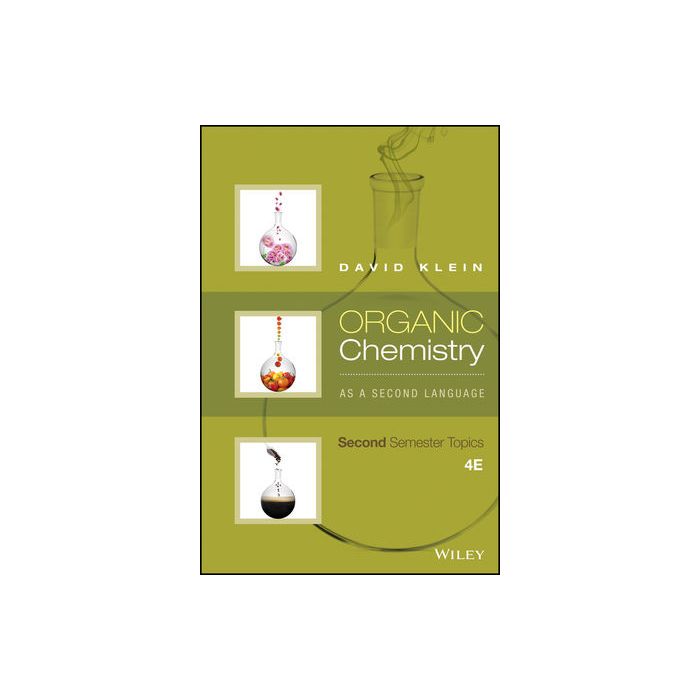Organic Chemistry As a Second Language: Second Semester Topics, 4ed. [Klein - Wiley - Blackwell]

- ISBN/EAN
- 9781119110651
- Editore
- Wiley - Blackwell
- Formato
- Brossura
- Anno
- 2016
- Edizione
- 4
- Pagine
- 400
Disponibile
193,10 €
Readers continue to turn to Klein's Organic Chemistry As a Second Language: Second Semester Topics, 4th Edition because it enables them to better understand fundamental principles, solve problems, and focus on what they need to know to succeed. The fourth edition explores the major principles in the field and explains why they are relevant. It is written in a way that clearly shows the patterns in organic chemistry so that readers can gain a deeper conceptual understanding of the material. Topics are presented clearly in an accessible writing style along with numerous hands-on problem solving exercises.
Maggiori Informazioni
| Autore | Klein David R. |
|---|---|
| Editore | Wiley - Blackwell |
| Anno | 2016 |
| Tipologia | Libro |
| Lingua | Inglese |
| Indice | Chapter 1 Aromaticity 1.1 Introduction to Aromatic Compounds 1.2 Nomenclature of Aromatic Compounds 1.3 Criteria for Aromaticity 1.4 Lone Pairs Chapter 2 IR Spectroscopy 2.1 Vibrational Excitation 2.2 IR Spectra 2.3 Wavenumber 2.4 Signal Intensity 2.5 Signal Shape 2.6 Analyzing an IR Spectrum Chapter 3 NMR Spectroscopy 3.1 Chemical Equivalence 3.2 Chemical Shift (Benchmark Values) 3.3 Integration 3.4 Multiplicity 3.5 Pattern Recognition 3.6 Complex Splitting 3.7 No Splitting 3.8 Hydrogen Deficiency Index (Degrees of Unsaturation) 3.9 Analyzing a Proton NMR Spectrum 3.10 13C NMR Spectroscopy Chapter 4 Electrophilic Aromatic Substitution 4.1 Halogenation and the Role of Lewis Acids 4.2 Nitration 4.3 Friedel-Crafts Alkylation and Acylation 4.4 Sulfonation 4.5 Activation and Deactivation 4.6 Directing Effects 4.7 Identifying Activators and Deactivators 4.8 Predicting and Exploiting Steric Effects 4.9 Synthesis Strategies Chapter 5 Nucleophilic Aromatic Substitution 5.1 Criteria for Nucleophilic Aromatic Substitution 5.2 SNAr Mechanism 5.3 Elimination-Addition 5.4 Mechanism Strategies Chapter 6 Ketones and Aldehydes 6.1 Preparation of Ketones and Aldehydes 6.2 Stability and Reactivity of C¨O Bonds 6.3 H-Nucleophiles 6.4 O-Nucleophiles 6.5 S-Nucleophiles 6.6 N-Nucleophiles 6.7 C-Nucleophiles 6.8 Some Important Exceptions to the Rule 6.9 How to Approach Synthesis Problems Chapter 7 Carboxylic Acid Derivatives 7.1 Reactivity of Carboxylic Acid Derivatives 7.2 General Rules 7.3 Acid Halides 7.4 Acid Anhydrides 7.5 Esters 7.6 Amides and Nitriles 7.7 Synthesis Problems Chapter 8 Enols and Enolates 8.1 Alpha Protons 8.2 Keto-Enol Tautomerism 8.3 Reactions Involving Enols 8.4 Making Enolates 8.5 Haloform Reaction 8.6 Alkylation of Enolates 8.7 Aldol Reactions 8.8 Claisen Condensation 8.9 Decarboxylation 8.10 Michael Reactions Chapter 9 Amines 9.1 Nucleophilicity and Basicity of Amines 9.2 Preparation of Amines through SN2 Reactions 9.3 Preparation of Amines through Reductive Amination 9.4 Acylation of Amines 9.5 Reactions of Amines with Nitrous Acid 9.6 Aromatic Diazonium Salts Chapter 10 Diels-Alder Reactions 10.1 Introduction and Mechanism 10.2 The Dienophile 10.3 The Diene 10.4 Other Pericyclic Reactions Answer Key Index |
Questo libro è anche in:
